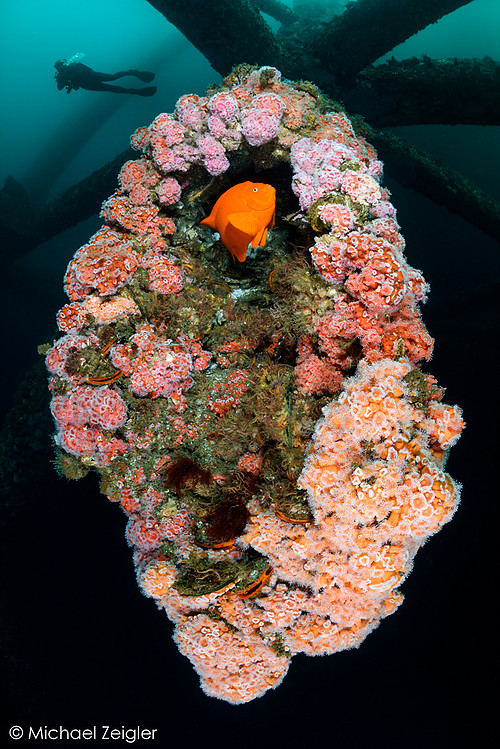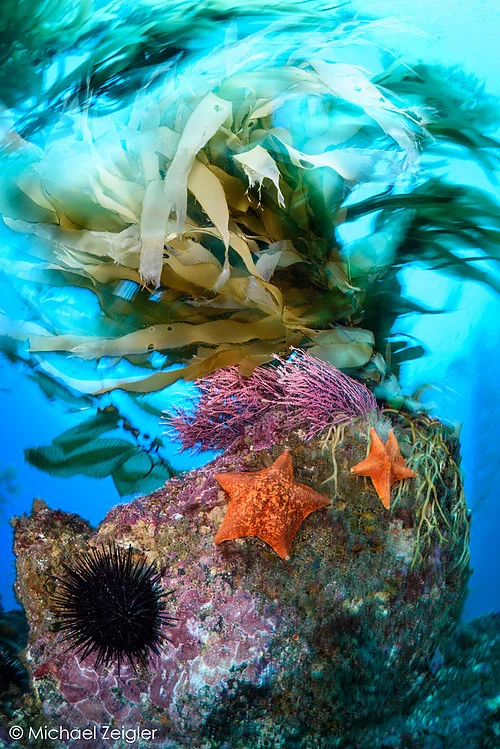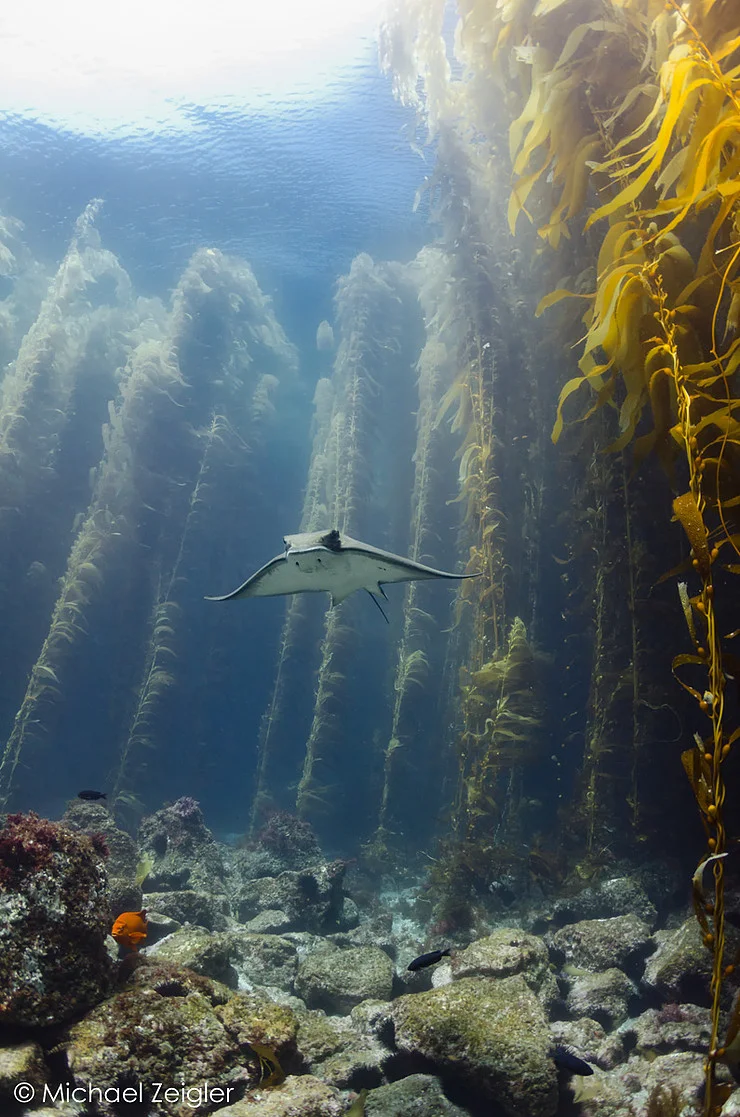Behind The Lens: Michael Zeigler
Madeline St Clair Baker
This week we caught up with Michael Zeigler - SoCal-based photographer, Nauticam ambassador and co-founder of Immersed Imaging. From shameless first camera to most sensational dive, join us as we venture behind the lens in this enchanting and entertaining interview…
Sitting across from me on Skype, but half a world away in California, Michael Zeigler and I are talking underwater cameras. But right now, not the kind you’re thinking about – the ones in fancy housings – but rather the small, compact kind. He proudly holds up a Canon Powershot, which has been collecting dust on the shelf nearby, the way one presents his first child. “So, it’s a basic point and shoot camera...” he says, “the only thing you can change is the ISO - you can’t even change the shutter speed or the aperture. But ever since I clicked the shutter, I thought ‘oh my god, this is rad.’” This relic of a camera marks Michael’s entry into the underwater photography scene. Gifted to him by his wife shortly after they were married, he holds her responsible for his obsession with all- things-photography: “I blame her for creating the monster I am today,” he says affectionately.
At the point of being gifted his first underwater housing, Michael’s approach to photography was, as he deftly puts it, “put it in auto mode and go to town”. That approach has since changed significantly; he quickly realized that to produce outstanding images, understanding the concepts of photography and shooting in manual mode were pretty essential. When he decided to upgrade, it took him a year to save up for his first proper housing – a DSLR Ikelite housing. His anecdote about the expense is oh-too relatable and gives me a first glimpse of his infectious humour: “oh you want a strobe, oh you want two strobes? Well then you need to give us your car... and your first born.” These days, as an ambassador for Nauticam and co-founder of photography company Immersed Imaging, Michael’s set-up has come a long way from the humble Canon Powershot; he currently sports a Nikon D850 in a Nauticam housing. And what about the rest of his gear? “For wide-angle? My primary go to lens is Sigma 15mm fisheye behind a 140mm mini dome. For macro – Nikon 105mm macro lens. For strobes – Ikelite DS160s.”
But his path to where his is now started far from the sea. Originally from the midwestern state of Michigan, Michael grew up far from the ocean, with rare vacations to Florida serving as his only connection to the sea. “After graduating college, I booked a one-way ticket to California and never looked back,” he pauses and smiles, “I was following a girl... isn’t it always a girl? After learning to dive in his early 30s and subsequently gaining his Rescue certification, he began volunteering at a local aquarium (in Long Beach). Though he joined diving a little late in the game, Michael has since made up for lost time, logging almost a thousand dives in just 12 years. Diving has become a family activity. He found himself a “permanent dive buddy “when his wife got certified during a vacation in Hawaii," and convinced his parents to try diving for the first time at 55 during a family holiday in Aruba. He’s also a father of two and I am curious to know if this passion for diving will extend to his children. “I’ll encourage them to the point where they say, hey dad – no. I’ll definitely encourage them as it’s such an amazing cert to have, you can take it with you for the rest of your life.” His daughter seems pretty keen already though: "she always says ‘Dad, I’m six now, and when I’m this many – I’m going diving’” he says with a laugh.
Michael is an easy interviewee. His capacity for storytelling is addictive and I find myself straying off topic, leaving cameras behind to ask about his favourite place to dive. Having lived there for the past 21 years, I am surprised when he tells me that it is Southern California. “The kelp forests are ridiculously diverse, there’s just so much beauty - I can’t get enough of it,” he says. “Sure, it’s not like the Caribbean, where you get pristine conditions with 200 ft vis, but in SoCal you never know what you’re going to get.” But what is diving in Kelp forests like? I tell him about my vision of being hit in the face and tangling my fins in fronds. “It can be like that when it’s super surge-y,” he agrees, “but when it's calm, it’s just like kicking though a little forest. And I’m sure a little more streamlined if you don’t have a big camera like mine. You find clearings and settle down and just watch.”
He speaks in more detail about a particular dive site; oil platforms, ten miles off the SoCal coast, with two rigs open to the public for diving. A quarter of a mile apart, they sit in the middle of the open ocean at around 275 ft and 700. And they’re not small either - you can probably circumnavigate the rig twice in a dive. But it’s the diversity of marine life that draws Michael there. “I’ve seen schools of tuna, mola, people have seen pelagic stingrays, white sharks, sea lions, diving birds, huge bait balls...” he says. “And all these sessile organisms live there [on the rig] too. The oil rig crew scrapes the rig often for the integrity of the structure, but the critters come back – anemones, mussels, scallops, sea stars, brittle stars... It’s magical.”
As we delve further into the dazzling world of marine life, I ask about his most memorable experience underwater. Michael thinks for a while and then informs me (to my delight) that he has not one, but two stories to tell - he feels the need to distinguish the most memorable from most sensational. “Not long after I had been certified I was on a night dive hunting for lobster – super bad vis. I just had my light, looking for the bugs,” he says, “and about two feet from me I see this huge, glowing orb – like a deer in a headlight – and I was like, dear god, what is that thing? And a second later it takes off right over my head.” But what was this mysterious creature? “A massive bat ray – kind of like an eagle ray – they get huge, primarily on the sea floor feeding in the sand for mussels and their wingspans get to like... 2 m.” He kindly converts to metric for my benefit.
We jump straight from the most memorable to the most sensational and his answer is a little more cliché. “The first time I saw a whale shark in the sea of Cortez,” he says, “I was a photographer at this point and had gone specifically to photograph them. I’d never been in the ocean with something as large as a whale shark before... and then I just went into image capturing mode – just solely focused on capturing the image.” He goes on to describe what it’s like to photograph these gentle giants. “For me, it’s all about positioning yourself correctly with these bigger critters. Make sure your camera is set up to capture the action – with the right auto-focus and exposure mode – and sun positioning. The sun is your only light source: do you want to have the sun in front of you and capture a silhouette? Or have it behind you and have the critter more illuminated?”
I think back to the vibrant nudibranchs I’ve seen on Michael’s Instagram feed and wonder out loud if it’s easier to photograph the smaller stuff. “It’s easy if the critter cooperates.” He concedes. “But you can be in the best spot and the critter is coming right at you and then whoop it changes direction. There’s a certain element of luck involved. You have to put yourself in position and hope the stars align so you get the shot.”
But it’s Michael’s bucket list that I find the most interesting answer of all. “I don’t have a bucket list of species per se,” he says, “but a bucket list of compositions of species that I have shot before.” It turns out that a wise man (by the name of Alex Mustard) once gave him a memorable piece of advice. “He told me that anything you shoot is going to be rare some place, and common somewhere else. So, take advantage of where they are common and get the best shots possible.” Michael explains. “So, you see, I have less of a critter list, than a composition list... I have compositional goals. Take the Solomon Islands for example, I went for the first-time last year. And before I go again next year, I’ll look through my library of images, and think ‘this critter was great... I’m going to shoot it this way next time’. Same critter – different images.”
Our conversation finally arrives back in the realm of photography and we discuss his advice for the budding young ocean photographers out there. “Become a good diver first.” His answer is simple and smacks of truth. “So many times, folks haven’t had their air consumption or buoyancy dialled-in. You need to feel comfortable in the protective gear you’re in. As soon as diving becomes second nature then I would encourage them to get into underwater photography.” Michael’s advice isn’t just to help focus the craft of a young photographer though, but to protect the marine environment. “I’ve seen it before, divers kicking and slicing giant sponges in half with their fins... just like butter. Spatial awareness is key and is extremely important in order to protect the marine environment in which we dive."
As we talk artificial light and photography concepts, Michael’s experience as a photography coach becomes evident, which I take to be a result of his passion project, Immersed Imaging. “Get the knowledge and then apply it underwater.” He says, “though it’s a bit different, underwater shooting from shooting topside. If you’re already into photography, then I would encourage you to abandon most of the concepts that you are familiar with – because they simply don’t apply.” Michael co-founded the photography workshop company with Todd Winner; the two met 6 years ago and hit it off after co-hosting a workshop in La Paz, Mexico. They sold some T-shirts, started booking gigs together and then decided to try their hand at running their own workshops. Since then, Immersed Imaging has gone from strength to strength, and now runs instructive photography trips across the globe. “It’s not our primary source of income - it’s our passion,” he says with a grin, “but I found a way for underwater photography to pay for itself.”
But it’s not just his photographic skills that I am impressed by, but his attitude towards ocean conservation. Michael’s “I do what I can – I act locally” philosophy is one that we could all learn something from. He’s a member of the Ocean Artists Society and seeks to encourage his kids through his own actions: “We use our own reusable straws, and when the family goes to the beach we each pick up at least three pieces of trash. People don’t realise about things like the importance of using reusable bags, it’s the small things that you do every day that really kind of add up.” His answer is heart-warming. But does he think perceptions are changing towards the ocean? “When you see big companies like Starbucks serving paper straws instead of plastic straws, I think it raises the eyebrows of people who are sceptical,” he says and grows the most serious that I’ve seen him during our conversation. “But what’s really going to change are the kids in high school now because they stand up and see it from a different view point – it is going to be my children who are going to grow up and make a difference. They are going to look at this and say, ‘What is this trashed-out world that you have just handed to us?’”
As the interview draws to a close, we are surprised to realise that almost an hour has passed - I feel as though I have barely scratched the surface of the enchanting, underwater world of Michael Zeigler. I decide to put him on the spot one last time and ask him to leave me with some final words of wisdom. He humours me with a grin. “Just this: in a nutshell, just be very conscious of the fact that the decisions we make every day – large and small – whether it’s picking up trash, using reusable straws, or recyclable bags, just be conscious of these in your day to day life.”






